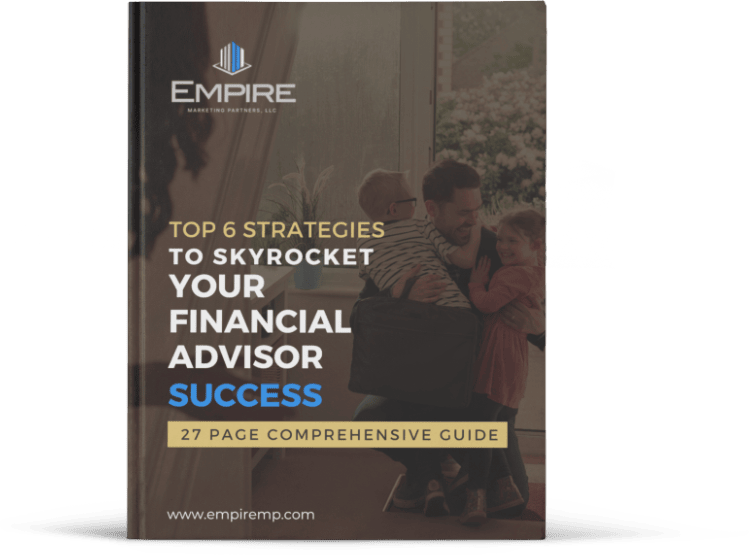Financial Advisor Strategies for Closing Deals from Empire Marketing Partners
“C’mon, Decide Already!”—Is that your inner voice when meeting with new clients?
We’ve all felt the urge to tell a hesitant client to make a decision outright. While it’s a natural frustration, we know that being that direct can backfire, leading to an immediate refusal.
Clients put off decisions for many reasons; some are reasonable, but often it’s simply because they don’t see an urgency in responding. They think, “What’s the hurry?”
Financial advisors must instill a sense of urgency. Prospects need to be guided toward making a definitive choice.
A typical reason for indecision is getting lost in too many options. When clients are presented with several alternatives, their instinct is to avoid committing to any, thereby delaying the decision and hesitating to pull the trigger.
Fortunately, there are numerous ways advisors can gently guide clients to a prompt decision without seeming overly aggressive or anxious. Here are eight effective strategies to close deals as a financial advisor:
1. Highlight the Impact of Inaction
One way to help hesitant clients make a decision is to explain that choosing to do nothing is, in fact, making a decision. This often puts things into perspective.
By keeping their money where it currently is, they are essentially deciding against your proposed strategy. Ask them to articulate the rationale behind this choice.

Why It Works
Clients often delay decisions because they don’t realize that inaction is actually a choice. By highlighting this, you help them understand the implications of their procrastination, and that no decision is a decision.
This technique prompts self-reflection and often makes them realize the urgency indirectly.
Best for
✅ Clients who are naturally indecisive or tend to avoid decisions.
✅ Analytical personalities who appreciate clear, logical reasoning.
Worst for
❌ Highly defensive or stubborn clients who may feel pressured or cornered.
Scenario
Imagine you’re speaking with a client who is hesitating. Gently say, “By not making a decision, you’re choosing to stick with the status quo. Can you help me understand what makes you comfortable with your current plan, despite the benefits we’ve discussed?”
2. Prepare Clients for the Decision-Making Process
Many advisors use a multi-step approach that starts with financial planning and ends with a proposal.
Consider gaining approval in advance by laying out the sequence of steps and explaining in advance the proposal presentation.

Why It Works
By setting clear expectations from the start, clients know exactly when and what decision they need to make. This structured approach reduces the likelihood of them feeling overwhelmed by decisions at the end of the process.
Best for
✅ Clients who prefer order and scheduled timelines.
✅ Detail-oriented individuals who appreciate knowing the full process upfront.
Worst for
❌ Spontaneous or flexible personalities who might feel constrained by predefined steps.
Scenario
During your first meeting, outline the steps clearly: “Our process includes initial financial planning, followed by a proposal presentation where we expect to make a decision.“
“Does this timeline work for you?” This way, when the proposal review meeting arrives, the client is prepared to make an informed choice, rather than postponing the decision indefinitely.
3. Outline their Objectives and Offer the Solutions
Throughout your proposal, consistently tie the elements you are recommending back to the client’s specific needs and objectives.

Why It Works
Connecting your proposal directly to the client’s personal needs makes the solution more relevant and attractive. It highlights how your services directly address their specific problems, making the value proposition clear.
Best for
✅ Clients who are goal-oriented and solution-focused.
✅ Individuals who need clear benefits aligned with their goals.
Worst for
❌ Those who are more emotionally driven and need softer approaches.
Scenario
When presenting a retirement plan, say, “Based on your goal to retire comfortably at 65, here’s how our proposed strategy will help you achieve that by addressing your need to maximize returns while minimizing risk.”
4. Lead the Next Move Forward in the Process
If you’ve explained your multi-step process at the start, move seamlessly to the next step by initiating the implementation phase, such as completing new account paperwork.

Why It Works
A seamless transition to implementation shows confidence in your proposal and reduces opportunities for second-guessing. It makes the decision appear as a natural progression rather than a separate, daunting task.
Best for
✅ Clients who appreciate decisive leadership and clear guidance.
✅ Busy individuals who prefer efficiency over deliberation.
Worst for
❌ Those who may feel hurried or pressured by seamless transitions.
Scenario
After presenting the proposal, say, “Great, the next step is to get started on the paperwork. Let’s fill out the new account forms together. This will ensure we’re ready to implement the plan as soon as you’re comfortable.”
5. Illustrate the Price of Procrastination
Explain to clients how delaying their decision can have a financial impact. If they choose to wait, follow up after a few weeks to demonstrate the potential costs or lost earnings due to their hesitation.

Why It Works
This method taps into the fear of missing out (FOMO). By quantifying the financial impacts of delay, you make the cost of inaction tangible, prompting more prompt decision-making.
Best for
✅ Clients driven by financial metrics and opportunities.
✅ Those responsive to timelines and quantified outcomes.
Worst for
❌ Highly anxious individuals who may feel overly stressed by potential losses.
Scenario
Reach out after a few weeks to illustrate the potential benefits of acting earlier on our plan. By moving forward last month, your portfolio could have grown by X%.
Recognizing that waiting may have missed an opportunity, let’s work together to prevent further losses by making a decision now.
6. Highlight Missed Opportunities
Interest rates and market conditions are cyclical. If a client waits too long, the opportunity may not be as favorable when they finally decide to take action.

Why It Works
By showing that timing is crucial, you instill a sense of urgency. People hate missing out on good opportunities, so highlighting this can prompt quicker action.
Best for
✅ Clients aware of market conditions and trends.
✅ Those who have missed opportunities before and want to avoid it again.
Worst for
❌ Risk-averse individuals who might feel pressured and become more hesitant.
Scenario
Explain, “I understand wanting to think it over, but remember, interest rates are in your favor now. Waiting could mean missed opportunities and less favorable rates in the future.”
7. Leverage Familiarity
People are naturally comfortable with what they know. Integrate some of their existing holdings into the new strategy and explain how this will bolster their success.

Why It Works
People are comfortable with what they know. By integrating familiar elements, you reduce the perceived risk of new decisions, making the transition smoother and more acceptable.
Best for
✅ Clients who are risk-averse and prefer stability.
✅ Older clients who may be more attached to their current holdings.
Worst for
❌ Adventurous investors seeking completely new opportunities.
Scenario
Say, “We can keep some of your current holdings that have performed well. Here’s how incorporating these into a diversified portfolio with our new recommendations can maximize your success.”
8. Appeal to Their WHY
Often, clients need to be reminded of why they are investing. Shift the conversation from numbers and percentages to their broader goals, such as providing for their family and building a secure future.

Why It Works
Shifting focus from abstract figures to personal, relatable goals taps into the emotional aspect of investing. It reconnects clients with their deeper motivations, which can move them to action.
Best for
✅ Clients driven by family and personal goals.
✅ Individuals who need an emotional connection to their financial decisions.
Worst for
❌ Highly analytical clients who prefer data-driven discussions.
Scenario
Say, “Let’s focus on your ultimate goal: ensuring your family’s financial security. Our plan isn’t just about numbers; it’s about creating a solid foundation for your loved ones.”
Concluding Closing The Hesitant Client
At Empire Marketing Partners, we understand the challenges of how financial advisors get clients and close deals.
Our team provides coaching on these techniques and more, ensuring you’re never alone in the process.
We help simplify complex financial planning and annuities, making it easier for you to close deals and provide the best solutions to your clients.
Ready to take your closing strategy to the next level? Reach out to Empire Marketing Partners today and let’s work together to ensure your success.






